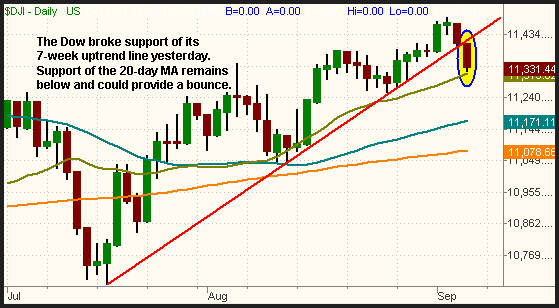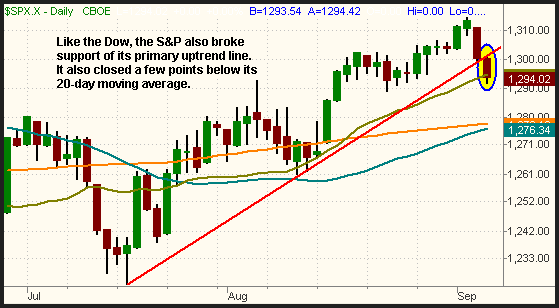Stocks followed through on the previous day's weakness, as the S&P 500 broke support of its primary uptrend line. The broad market attempted to recover from its opening gap down by rallying in the early afternoon, but the bears resumed control in the final ninety minutes of trading. The S&P 500 lost 0.5%, the Nasdaq Composite 0.6%, and the Dow Jones Industrial Average 0.7%. The small-cap Russell 2000 slid another 0.8%, while the S&P Midcap 400 closed 0.6% lower. Each of the major indices finished in the bottom third of their intraday ranges, though the Dow showed relative weakness by closing below its morning low. Even the StreetTRACKS Gold Trust (GLD) plummeted 2.5%, causing it to fail its recent breakout above its 50-day moving average and primary downtrend line. As such, we made a decision to cut the loss quickly and sell the position ahead of its original stop.
Turnover rose across the board, causing both the S&P and Nasdaq to register their second consecutive "distribution days." Total volume in the NYSE was 3% higher than the previous day's level, while volume in the Nasdaq increased by 2%. Volume has increased in each of the three trading days since the Labor Day holiday, but institutions have, so far, been selling into strength of the late August gains. Of the past three sessions, both the S&P and Nasdaq posted gains on Tuesday, but recall our cautionary comments that the price action resembled bearish "churning" more than a bullish "accumulation day." For astute traders, this was an early warning sign of the losses that followed in the two subsequent days. Market internals were negative, but not by as wide a margin as the previous session. In both exchanges, declining volume exceeded advancing volume by approximately 2 to 1.
In just two days, the S&P 500 has given back the gains of the past two weeks. Unfortunately for the bulls, this is what commonly occurs when stocks creep higher with extremely light volume levels. The retail "mom and pop" investors buy stocks in all market conditions, including the summer doldrums, simply because they are conditioned to do so. But hedge funds, mutual funds, and other institutions often see that retail buying interest as an opportunity to sell into strength when they return back to regular trading activity. That is why we were reluctant to buy any ETFs in the latter half of August, other than for quick two to three day momentum plays. It appears our cautious stance was warranted.
The S&P 500 also closed yesterday firmly below support of its primary uptrend line that we illustrated in yesterday's The Wagner Daily. The Dow Jones Industrial Average similarly fell below its seven-week uptrend line as well. In reality, the Dow is a narrow-based index that includes only thirty blue chip stocks, but it remains a popular index that the general public views as a barometer for the overall market's health. As such, we follow the performance of the Dow simply to keep up with overall market sentiment. The Dow's break of its uptrend line is illustrated on the daily chart below (the red ascending line):

Although the Dow broke support of its uptrend line, notice that it closed just above its 20-day moving average. This could provide a bit of support for the Dow, but the problem is that the prior uptrend line has now become a new area of resistance. If the 20-day MA fails to hold, expect the Dow to bounce off its 50-day moving average, presently at 11,171. The daily chart pattern of the S&P 500 is similar to the Dow, except that the S&P actually closed a few points below its 20-day MA:

If the S&P fails to bounce off this 20-day MA, the next major area of support should be at convergence of the 50 and 200-day moving averages, around the 1,276 level. Because each of the major indices formed a "lower high" off their prior highs from May, the broad market remains in a primary downtrend. Since mid-July, the indices have been in an intermediate-term uptrend, but the rally has simply been a strong bounce within the context of the longer-term downtrend. If looking for a short-selling entry point to take advantage of the primary downtrend, the break of the intermediate-term uptrend lines provides an ideal place to do so. Admittedly, we were a bit early to the party by attempting to sell short a few of the broad-based ETFs while the light volume rally was still occurring, rather than waiting for the actual resumption of the primary downtrend. Short sales made in anticipation of key resistance levels often work well, but you can throw most technical analysis rules out the window when volume evaporates.
For a low-risk short entry point in the broad market, we would like to see another day of losses, then a one to two day rally in the early part of next week. Remember that the prior uptrend lines in the S&P and Dow should now act as resistance, so a rally up to near those levels would be ideal. If, however, the indices snap back above their prior uptrend lines, all bets are off on the short side. For today, we plan to lay low and observe the stock market's behavior, especially the relationship between price and volume. We will be ready to enter a few new positions next week, depending on market conditions.
Deron Wagner is the Founder and Head Trader of both Morpheus Capital LP, a U.S. hedge fund, and Morpheus Trading Group, a trader education firm launched in 2001 that provides daily technical analysis of the leading ETFs and stocks. For a free trial to the full version of The Wagner Daily or to learn about Wagner's other services, visit MorpheusTrading.com or send an e-mail to deron@morpheustrading.com.